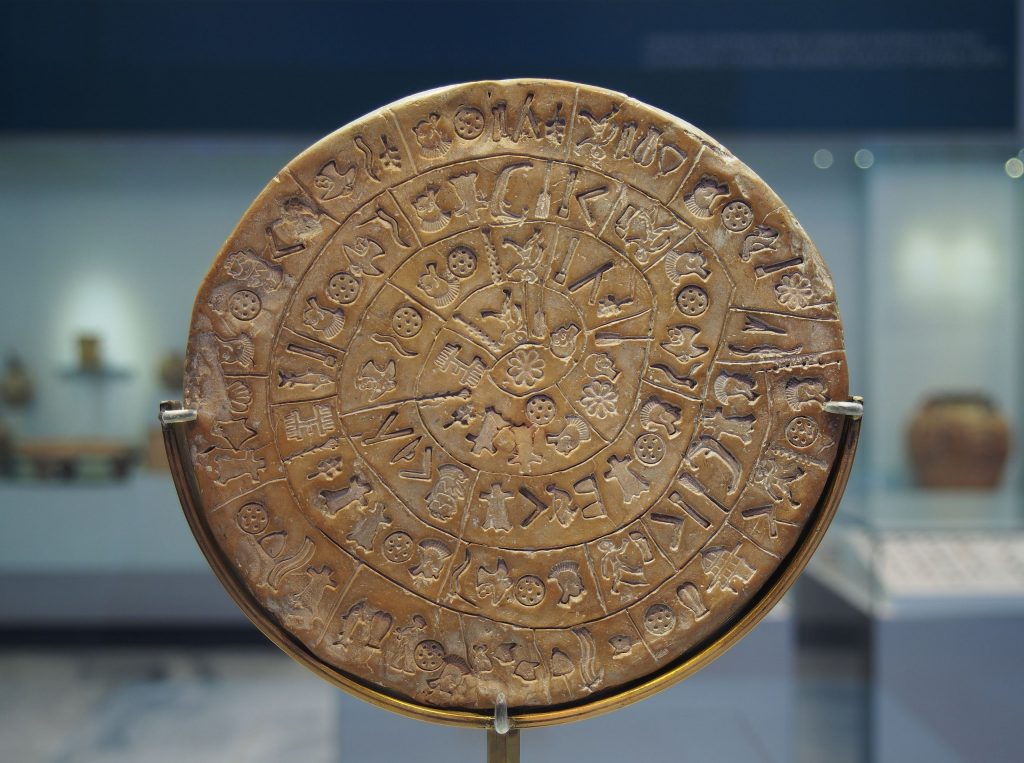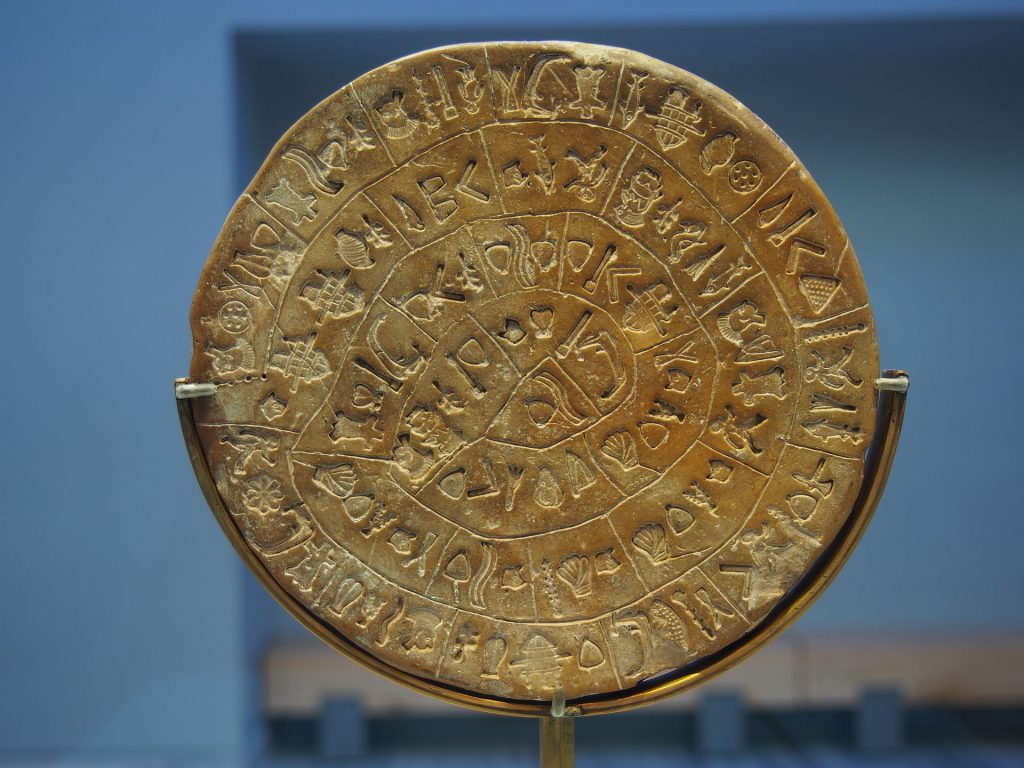The Phaistos disc (disk)
By Daniel Thomlinson
This tablet is from the Phaistos Palace ruins on the Greek island of Crete. After several years of analysis, this artefact was dated to c. 1700-1650 BCE; the Minoan period and is extensively inscribed with spiralling script. Despite the lengthy debate over its authenticity, it shares undeniable similarities with other artefacts of confirmed Minoan heritage. The disc is weathered and irregular – measuring 15.8-16.5cm in diameter and 2.5 cm thick – but, crucially, the script is unobscured. As of January 2023, this is the only artefact known to bear this script, but has resisted countless attempts at translation, therefore, it is reasonable to assume that this disc was produced individually for an unknown and specialised purpose. Given its age, it is not unusual for the context it existed in to be lost, but the Phaistos disc is one of the best examples of a nigh-unsolvable mystery. The lack of valid translation and what this means for the study of epigraphy is therefore a primary focus of this work. I initially chose it due to its lack of decipherment, becoming interested after visiting it at the Archaeological Museum at Heraklion but the Phaistos disc continues to intrigue me; however, the absence of solid evidence is staggering, and has resulted in an exceptionally murky field of study which I hope in the future will become clearer.
The disc is terracotta clay, a material used in many artefacts found from the period, including vases discovered at the same site. Most small scale writing from the time was done on clay tablets (these examples bearing the pictographic Linear A and B scripts common to Minoan Crete) therefore no symbolic significance can be derived from the choice of material. That the disc remains in a single piece after more than three and a half thousand years is incredible considering the state of most other surviving historical artefacts. The clay would have been shaped while wet then inscribed with the guidelines seen on the tablet before the surface was stamped with tiny seals to create the pictograms we see now. Since these signs were stamped, the case may be – despite the lack of further material evidence – that either this script was used extensively, or that the symbols were complex enough to require a method of easy replication. Ephron, whose work is out of date and therefore somewhat unreliable, mentions that this system of stamp-based writing is “a cumbersome method, one which must have been extremely slow and exasperating.” He provides this as a reason for the script possibly being short-lived and representing a pre-Linear B script due to the complexity of the signs present. It is unknown where or by whom this object was made beyond the assumption that it was made locally based on its unique script.
There have been many estimations on the use or function of this tablet ranging from an ancient alphabet to an object of religious significance. “One main cause may be a missing second object with similar symbols in the same ‘alphabet’ to compare to the disk’s symbols.” But as stated by Wolfgang later, the scripts origin has been speculated upon widely – “Suggested decipherments are legion, and the propositions go in all possible and imaginary directions.” Noting that further attempts at decipherment would currently be unhelpful. As an alternative to the currently fruitless attempts to translate the symbols used in the inscription, several scholars have instead concentrated their focus on the lines which direct the discs spiral of symbols. Many of these scholars have suggested a mathematical use for this structure, possibly a celestial link such as dating an eclipse or tracking a calendar. Unlike many inscriptions which were on public display – this object is inscribed with a different sequence of symbols on each side, suggesting it was freestanding rather than wall-mounted, or, like many religious artefacts, it may have been stored or buried so the text would not have been on display at all. Alternatively, the disc may have been circulated rather than displayed, suggesting a communicative role akin to a letter; but this is merely speculation. The script is a pictographic collection of 45 different signs across the two sides of the disc which contains 241 signs in total. After some academic debate, it was agreed that the script is meant to be read following the guidelines from the outer edge to the centre starting with a line of five dots on each side. The script bears tenuous similarity to inscriptions on an ax found in the Arkalochori cave nearby in 1934, particularly signs 02, and 19 on fig. 3. In turn, the symbols on the ax also bear similarity to Linear A. This is not conclusive proof that these scripts are related but does display visual similarity between examples of Minoan scripts. This ax is believed to be a votive offering, possibly suggesting that the Phaistos disc may have been afforded a similar function. However, the translated examples of Linear A and B we have, tend to be simple texts, largely lists of ownership, which suggests that such pictographic scripts were limited by their simplicity and rarely used to represent complex ideas or functions. The as-yet untranslated inscription makes the Phaistos disc one of the most important artefacts in the field representing the future of archaeology – A reminder that there are still mysteries yet to be uncovered.
This disc was discovered by Italian archaeologist Luigi Pernier, on Crete in the north-eastern area of the Palace of Phaistos on July 3rd, 1908. It is currently held in the Archaeological Museum at Heraklion, the most prominent archaeological museum in the region, where it has been since its discovery, displayed on a stand in their hall, becoming the source of ceaseless academic speculation since. The Phaistos disc is relatively infamous both among scholars and non-academics for its elusive nature and inscrutability. This is reflected in the biography given by the museum, which includes a theory on the disc’s purpose – that the inscription is “a hymn or incantation.” The scholarship surrounding the Phaistos disc is plagued with mistakes and disagreement; “P. Faure, for example, deliberately introduces some signs in the text to make it read the way he wants.” This editing of source material to achieve an ulterior aim through specific translation is a common issue in the study of epigraphy and is no less present in the scholarship of this artefact. The lion’s share of academic scholarship relating to this inscription – of those works written in English – tends to have been produced by affluent twentieth century scholars, which limits discussion from that era to egotistical criticism of others attempts and selections of academia rife with mistakes and other issues which remove the validity of many claims. There are still modern scholars working on the Phaistos disc attempting to uncover new information, but as Daniels and Bright stated in their relatively pessimistic and limited entry on the Phaistos Disc as part of their collection on The worlds writing systems “nothing suggests that a verifiable decipherment will ever be achieved (Olivier 1975, Duhoux 1977, Chadwick 1987).”6 While this sentiment has undoubtedly been shared by any and all who have studied this artefact at some point, I do not believe our comprehension of this tablet will remain at its current level forever. The Phaistos disc remains fascinating and important to the study of epigraphy due to the inherent issues in studying such objects combined with its potential in uncovering the history of Crete and inscriptions as a field. The scholarship surrounding this object represents the stagnation which many subjects suffer from when very little evidence is available over an extended period of time, as adding anything new to this field is unfortunately almost impossible and infighting between scholars is seemingly inevitable. However, this academic discourse does not diminish the allure of the disc or its inscription.
Based on my own research, the Phaistos disc is a Minoan artefact dating to around 1600 BCE, which, despite its lack of translation, is an example from a short-lived Cretan pictographic script developed as an alternative to the existing Linear A. Due to its complexity, it was not widely used, perhaps limited only to the palace of Phaistos and its surrounding lands. The script was replaced later by Linear B, a more easily replicable script which due to its popularity spread further and more successfully than the ‘Phaistos script’. The object itself was probably religious in nature, representing a prayer, or was an attempt to quantify some element of the natural world such as a calendar or the movement of celestial bodies. Either way I do not believe it was meant to be displayed but was instead private. Unfortunately, this is all relegated to the realm of speculation until more can be discovered about the disc, the culture, or the script.
Bibliography
Daniels, Peter T. & Bright, William. (Eds.)., The worlds’ writing systems (1996), Oxford University Press.
Duhoux, Yves., How not to decipher the Phaistos disc: a review (2000), American Journal of Archaeology 104, 597-600.
Ephron, Henry D., Hygieia Tharso and Iaon: The Phaistos Disk (1962), Harvard Studies in Classical Philology Vol.66, 1-91.
Wolfgang, Reczo., Analysing and dating the structure of the Phaistos disk (2009), Archaeological and Anthropological Sciences 1, 241-245.
Heraklion Museum website


